

Quantum chromodynamics. In theoretical physics, quantum chromodynamics (QCD) is a theory of strong interactions, a fundamental force describing the interactions between quarks and gluons which make up hadrons such as the proton, neutron and pion.
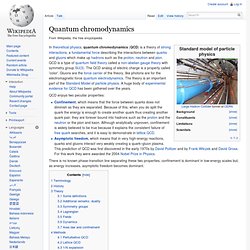
QCD is a type of quantum field theory called a non-abelian gauge theory with symmetry group SU(3). The QCD analog of electric charge is a property called 'color'. Gluons are the force carrier of the theory, like photons are for the electromagnetic force quantum electrodynamics. The theory is an important part of the Standard Model of particle physics.
A huge body of experimental evidence for QCD has been gathered over the years. QCD enjoys two peculiar properties: Confinement, which means that the force between quarks does not diminish as they are separated. There is no known phase-transition line separating these two properties; confinement is dominant in low-energy scales but, as energy increases, asymptotic freedom becomes dominant. Terminology[edit] History[edit] Photoelectric effect. The photoelectric effect is the observation that many metals emit electrons when light shines upon them.
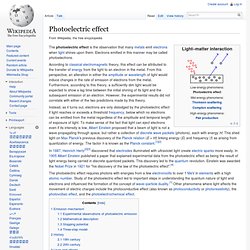
Electrons emitted in this manner may be called photoelectrons. According to classical electromagnetic theory, this effect can be attributed to the transfer of energy from the light to an electron in the metal. From this perspective, an alteration in either the amplitude or wavelength of light would induce changes in the rate of emission of electrons from the metal. Furthermore, according to this theory, a sufficiently dim light would be expected to show a lag time between the initial shining of its light and the subsequent emission of an electron. However, the experimental results did not correlate with either of the two predictions made by this theory.
In 1887, Heinrich Hertz[2][3] discovered that electrodes illuminated with ultraviolet light create electric sparks more easily. Emission mechanism[edit] Experimental observations of photoelectric emission[edit] Quantum field theory. Quantum electrodynamics. In particle physics, quantum electrodynamics (QED) is the relativistic quantum field theory of electrodynamics.
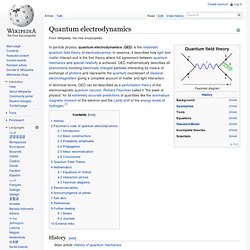
In essence, it describes how light and matter interact and is the first theory where full agreement between quantum mechanics and special relativity is achieved. QED mathematically describes all phenomena involving electrically charged particles interacting by means of exchange of photons and represents the quantum counterpart of classical electromagnetism giving a complete account of matter and light interaction. History[edit] The first formulation of a quantum theory describing radiation and matter interaction is attributed to British scientist Paul Dirac, who (during the 1920s) was first able to compute the coefficient of spontaneous emission of an atom.[2] Difficulties with the theory increased through the end of 1940. QED has served as the model and template for all subsequent quantum field theories.
Feynman's view of quantum electrodynamics[edit] Introduction[edit] or. Quantum Diaries. We’ve been discussing the Higgs (its interactions, its role in particle mass, and its vacuum expectation value) as part of our ongoing series on understanding the Standard Model with Feynman diagrams.
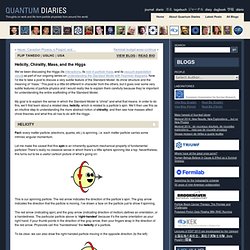
Now I’d like to take a post to discuss a very subtle feature of the Standard Model: its chiral structure and the meaning of “mass.” This post is a little bit different in character from the others, but it goes over some very subtle features of particle physics and I would really like to explain them carefully because they’re important for understanding the entire scaffolding of the Standard Model. My goal is to explain the sense in which the Standard Model is “chiral” and what that means. In order to do this, we’ll first learn about a related idea, helicity, which is related to a particle’s spin. We’ll then use this as an intuitive step to understanding the more abstract notion of chirality, and then see how masses affect chiral theories and what this all has to do with the Higgs. Helicity. Quantum Physics Online. Quantum Physics made simple.
On Pauli and the Interconnectedness of all things. There's been some argument on twitter and elsewhere as to whether Brian Cox made a mistake in his excellent "Night with the Stars" earlier this year.
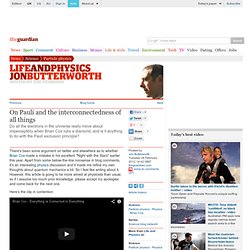
Apart from some below-the-line nonsense in blog comments, it's an interesting physics discussion and it made me refine my own thoughts about quantum mechanics a bit. So I feel like writing about it. However, this article is going to be more aimed at physicists than usual, so if I assume too much prior knowledge, please accept my apologies and come back for the next one. Here's the clip in contention: The controversy is about whether all the electrons in the universe really move energy levels imperceptibly when Brian heats the diamond, whether it's instantaneous, and whether it is anything to do with the Pauli exclusion principle.
Brian's main response to criticism so far has been to point to these lecture notes by his co-author Jeff Forshaw. And here's a response from Sean Carroll (which also links to some previous blogs). So...